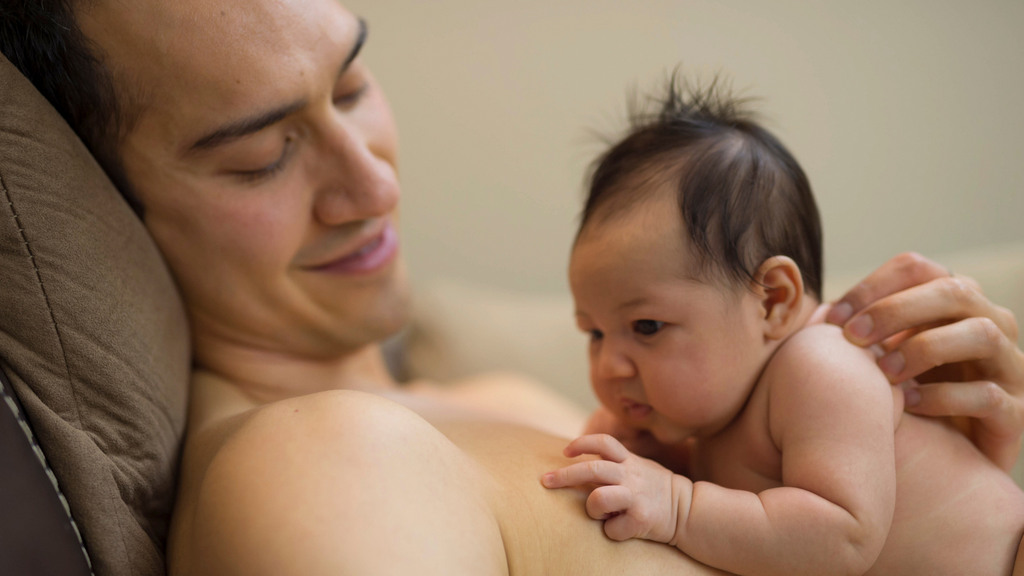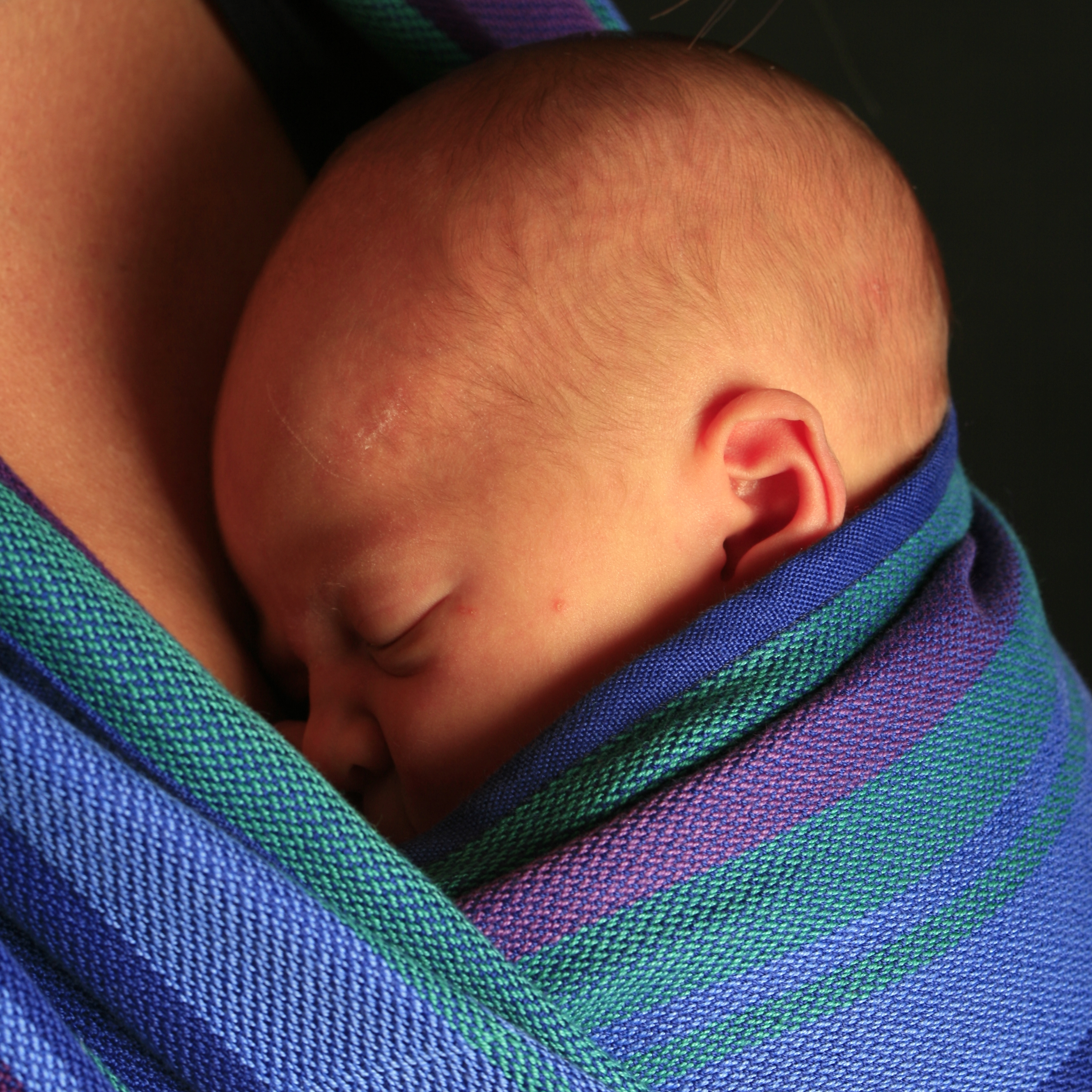
What do we mean by skin-to-skin?
For newborn babies, this involves a contact between the baby, who should be naked, and their bare-chested parent for as much contact as there can be between their bodies as is possible. As the days, weeks and months go by, the practice of keeping the baby close, even if lightly dressed, with its cheek and hands against the parent's torso, will also be considered as proper skin-to-skin. Its benefits are legion and widely known. The more frequently it is practised, the more its effects will be felt and will be experienced on a greater time span. Skin-to-skin is recommended from the moment of the baby's birth and throughout its first year.
Nowadays, most institutions where babies are delivered promote and recommend skin-to-skin from the moment the baby is born and through its first hour of life. Their staff will go as far as delaying non-urgent care like the baby's weighting and cleaning so as to avoid separating him from its mother. Should the mother be in need of an urgent medical intervention and find herself unable to hold her baby in skin-to-skin, her partner or another family member can be asked to care for the baby. The value of skin-to-skin with the baby in its first moments is in how it allows its mother to familiarize herself with her newborn and observe it, which diminishes her stress level and her baby's, and learn to recognize the signs that it needs to be fed. This will also allow her to more easily recover from having given birth and ease her into starting to breastfeed her baby. For her newborn, skin-to-skin will make for a gentler transition into life after birth and helps to appease him after the stress of being born, which can become an intense, difficult, and possibly very long hours.
Having the baby spend time skin-to-skin with either parent will bring him many benefits. His body temperature's stabilization, a regular heartbeat, a good blood glucose level (sugar level) and good oxygenation will all be helped by skin-to-skin. The newborn's fundamental instinct of crawling to one of his mother's areola to feed himself will also be facilitated by these precious instants together.
Something important needs to be mentioned: the many research projects, studies and testimonies all point to the same conclusion that skin-to-skin during the baby's first hour of life and the following days, weeks, months and years drastically reduce the baby's crying. Not only the baby seldom cries during its first hour but also throughout its first year during skin-to-skin sessions. It has also been confirmed that a child who has enjoyed long and frequent skin-to-skin contacts will experience less anxiety all the way into his adult years.
Babies have a physiological need to be with their mother but skin-to-skin can also be done with their father. Studies have shown that a newborn regularly kept in skin-to-skin is much less stressed and has a tendency to cry less often than one left in his crib or simply apart from his parent's body.
Skin-to-skin is also helpful in the baby's development of his immune system due to the time spendt against his mother's skin where bacteria might be present. Breastfeeding is also made easier by the production of oxytocin (nicknamed the 'love hormone'), which itself promotes the free flow of her breast milk. This will be helpful in becoming self-assured and confident in her maternal skills and instincts. Skin-to-skin will also fortify the link between mother and child but also solidifies the father's bond with his baby, as it will also diminish his stress hormone by promoting his self-confidence as a new father.
How should skin-to-skin be done?
The technique is simple but a little advice can ensure a safe experience. In the first few hours, both baby and parent should be bare-chested to ensure a maximum of contact between them. Placing the baby with his head slightly turned to the side and one cheek on his parent between and above his mother's breasts, have his knees raised and legs opened in a crouched position so that the inside of the baby's legs, stomach, his arms folded and his hands near his head create the best possible contact with his caregiver's skin. What's left to verify is that his airway stays clear by keeping the baby's face, nose and mouth visible. Ideally, the parent should stay still in a half-leaning position with their baby lying flat on their chest.
Evidently, it's difficult for new parents to spend several hours a day lying down with their baby. A recommended solution is to do it as much as possible during the baby's first 6 days and to switch between parents and other family members so as to manage to reach 2 hours per day. As time goes by, it's through babywearing that skin-to-skin will continue, at which point the parents will have the freedom to do their chores, move about and generally enjoy more freedom of movement while doing it.
Babywearing is the natural continuation of skin-to-skin care and should be done as often as possible, as it will grant parents and their child its advantages for much longer. To carry your child, we recommend the use of a baby wrap or baby carrier so as as to be able to care for your child while keeping your arms free.
To learn more about the benefits of babywearing, we recommend you our article on the topic and our video collaboration with the founder of Porter la vie and co-founder of the INPE Janie Vachon (in French). We've also prepared a condensed video on the many benefits of babywearing.
Let's sum it up!
The benefits of skin-to-skin:
-
Eases the transition to life after birth
-
Regulating the baby's body temperature and heartbeat
-
Easier breastfeeding
-
Higher secretion of oxytocin
-
Fortifies the baby's immune system
-
Lessens crying
-
Lowers anxiety and stress even as an adult
-
Bonding between mother and child / father and child
-
Greater confidence in parental skills
How:
-
First hour at birth
-
2 hours per day during the first 6 days
-
1 hour per day / every day for the first 12 months
-
Both with their torsos naked during the first few days and as often as possible, then with very few clothes later on.
-
In a half-sitting, half-leaning position whenever possible, if not then using a baby carrier and with as little movement as possible.
To be in contact with your baby as much as possible throughout your day will diminish his cries, the studies and testimonies prove it. A baby doesn't need to express distress when his need for touch is fulfilled, feels comfortable and happy!
*****
Do you have questions on babywearing? Visit our Frequently Asked Questions page. We also share content and advice about babywearing on our YouTube page.


Share:
7 Benefits of Babywearing for a Healthier and More Gentle Life With Baby
Which Carry Should I Use for My Needs?